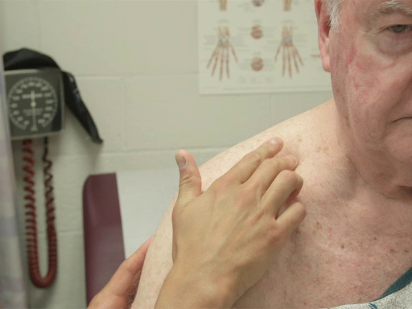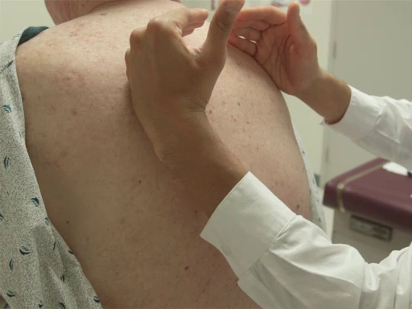Abstract
Protocol
Discussion
References
Physical Examinations I
Palpation
Published: April 30th, 2023
The physical examination requires the use of all of the provider's senses to gain information about the patient. The sense of touch is utilized to obtain diagnostic information through palpation.
The specific parts of the examiner's hand used for palpation differ based on the body part being examined. Because of their dense sensory innervation, the finger pads are useful for fine discrimination (e.g., defining the borders of masses, lymph nodes) (Figure 1). The dorsal surface of the hand provides a rough sense of relative temperature (Figure 2). The palmar surfaces of the fingers and hands are most useful for surveying large areas of the body (e.g., abdomen) (Figure 3). Vibration is best appreciated with the ulnar surface of the hands and 5th fingers (e.g., tactile fremitus) (Figure 4).
While palpation is fundamental to the diagnostic aspect of the physical exam, it is also important to acknowledge the role that touch plays in communicating caring and comfort during the patient encounter. Patients generally perceive touch from a healthcare provider in a positive light, and their perceptions of a healthcare provider can be shaped by the skilled use of touch during clinical encounters.1 Physical contact has been associated with alterations in hormonal and neurotransmitter levels, specifically decreases in cortisol and increases in serotonin.2
Therefore, through the careful use of palpation, and touch in general, during the physical examination, the clinician has the opportunity to gain important diagnostic information, while developing rapport and promoting healing.

Figure 1. Lymph node examination with finger pads.

Figure 2. Using the dorsum of hand to assess for warmth.

Figure 3. Abdominal palpation with palmar surface of fingers and hands.

Figure 4. Using the ulnar surface of the hand to assess for tactile fremitus.
1. Before the patient encounter
- Keep fingernails clean, groomed, and trimmed.
- Wash your hands with soap and water or topical disinfectant solution.
- Warm your hands as able (e.g., with warm water or by rubbing them together) before patient contact.
- If any specific infection control precautions are needed for the clinical encounter (e.g., contact precautions), explain to the patient why you are wearing protective equipment. Be aware that gowns, gloves,.......
This demonstration covered the general considerations related to palpation during the physical examination. While specific techniques vary based on each individual portion of the exam, many general principles related to palpation hold throughout the exam. Attention to patient safety and comfort is achieved through hand-washing, proper grooming, warming of the hands, infection control precautions, and sensitive draping. The correct part of the fingers and hands should be used for different types of palpation, with finger .......
- McCann, K., McKenna, H.P. An examination of touch between nurses and elderly patients in a continuing care setting in Northern Ireland. Journal of Advanced Nursing. 18, 838-46 (1993).
- Field, T. Violence and touch deprivation in adolescents. Adolescence. 37 (148), 735-749 (2002).
- Verrees, M. Touch me. JAMA. 276 (16), 1285-1286 (1996).
ABOUT JoVE
Copyright © 2024 MyJoVE Corporation. All rights reserved